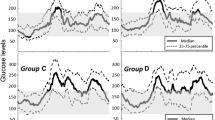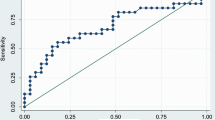Abstract
Objective: The relative contribution of fasting and post-prandial glucose to glycated hemoglobin (HbA1c]) is controversial. In the present study, we assessed the relationship with HbA1c of fasting and post-prandial glucose measured in a more naturalistic setting, through home glucose self-monitoring or with a continuous glucose monitoring system (CGM). Materials and methods: A consecutive series of 300 patients with Type 2 diabetes were enrolled in the study, provided that they performed blood glucose self-monitoring. HbA1c and fasting plasma glucose (FPG) were measured at enrolment. Results: Both fasting plasma and capillary glucose showed a significant correlation with HbA1c (r=0.66 and 0.61, respectively; p<0.001). When home glucose monitoring was considered, both mean fasting and post-prandial glucose showed a significant correlation with HbA1c (r=0.71 and 0.73, respectively). In patients in the lower tertile of body mass index (BMI), HbA1c showed a significant correlation at multivariate analysis with post-prandial glucose, but not with fasting glucose. In patients with HbA1c >7%, both fasting and post-prandial glucose showed a significant correlation, after adjustment for age and BMI, with HbA1c (both p<0.01); conversely, in those with HbA1c ≤7%, such a correlation could be observed for fasting (p<0.01), but not for postprandial glucose. Conclusion: In conclusion, both fasting and post-prandial glucose contribute to the determination of HbA1c. Home glucose self-monitoring appears to provide a more accurate assessment of metabolic control than a single plasma glucose measurement in experimental conditions. Fasting glucose could provide a greater contribution to HbA1c in patients with lower HbA1c, while post-prandial glucose seems to play a major role in leaner Type 2 diabetic subjects.
Similar content being viewed by others
References
American Diabetes Association. Standards of Medical Care in Diabetes-2006. Diabetes Care 2006, 29: S4–42.
Bonora E, Calcaterra F, Lombardi S, et al. Plasma glucose evels throughout the day and HbA(1c) interrelationships in type 2 diabetes: implications for treatment and monitoring of metabolic control. Diabetes Care 2001, 24: 2023–9.
Trovati M, Ponziani MC, Massucco P, et al. Blood glucose pre-prandial baseline decreases from morning to evening in type 2 diabetes: role of fasting blood glucose and influence on post-prandial excursions. Eur J Clin Invest 2002, 32: 179–86.
Bouma M, Dekker JH, de Sonnaville JJ, et al. How valid is fasting plasma glucose as a parameter of glycemic contro in non-insulin-using patients with type 2 diabetes? Diabetes Care 1999, 22: 904–7.
Avignon A, Radauceanu A, Monnier L. Nonfasting plasma glucose is a better marker of diabetic control than fasting plasma glucose in type 2 diabetes. Diabetes Care 1997, 20: 1822–6.
Monnier L, Lapinski H, Colette C. Contributions of fasting and postprandial plasma glucose increments to the overall diurnal hyperglycemia of type 2 diabetic patients: variations with increasing levels of HbA(1c). Diabetes Care 2003, 26: 881–5.
Woerle HJ, Pimenta WP, Meyer C, et al. Diagnostic and therapeutic implications of relationships between fasting, 2-hour postchallenge plasma glucose and hemoglobin a1c values. Arch Intern Med 2004,164: 1627–32.
Mastrototaro J. The MiniMed continuos glucose monitoring system (CGMS). J Pediatr Endocrinol Metab 1999, 12: 751–8.
Ito C, Maeda R, Ishida S, Sasaki H, Harada H. Correlation among fasting plasma glucose, two-hour plasma glucose levels in OGTT and HbA1c. Diabetes Res Clin Pract 2000, 50: 225–30.
Muggeo M, Zoppini G, Bonora E, et al. Fasting plasma glucose variability predicts 10-year survival of type 2 diabetic patients: the Verona Diabetes Study. Diabetes Care 2000, 23: 45–50.
Brichard SM, van den AE, Ketelslegers JM, Lambert AE. Home blood glucose monitoring, glycosylated hemoglobin and fructosamine: their relationships in diabetic patients with and without residual C-peptide secretion. Diabetes Metab 1989, 15: 388–393.
Gastaldelli A, Miyazaki Y, Pettiti M, et al. Metabolic effects of visceral fat accumulation in type 2 diabetes. J Clin Endocrinol Metab 2002, 87: 5098–103.
Garca-Estevez DA, Araujo-Vilar D, Saavedra-Gonzalez A, Fiestras-Janeiro G, Cabezas-Cerrato J. Analysis of the relationship between body mass index, insulin resistance, and beta-cell function: a cross-sectional study using the minimal model. Metabolism 2004, 53: 1462–1466.
Lyssenko V, Almgren P, Anevski D, et al. Predictors of and longitudinal changes in insulin sensitivity and secretion preceding onset of type 2 diabetes. Diabetes 2005, 54: 166–74.
Osei K, Rhinesmith S, Gaillard T, Schuster D. Impaired insulin sensitivity, insulin secretion, and glucose effectiveness predict future development of impaired glucose tolerance and type 2 diabetes in pre-diabetic African Americans: implications for primary diabetes prevention. Diabetes Care 2004, 27: 1439–46
Vaccaro O, Ruffa G, Imperatore G, Iovino V, Rivellese AA, Riccardi G. Risk of diabetes in the new diagnostic category of impaired fasting glucose: a prospective analysis. Diabetes Care 1999, 22: 1490–3.
Author information
Authors and Affiliations
Corresponding author
Rights and permissions
About this article
Cite this article
Monami, M., Lamanna, C., Lambertucci, L. et al. Fasting and post-prandial glycemia and their correlation with glycated hemoglobin in Type 2 diabetes. J Endocrinol Invest 29, 619–624 (2006). https://doi.org/10.1007/BF03344161
Accepted:
Published:
Issue Date:
DOI: https://doi.org/10.1007/BF03344161




